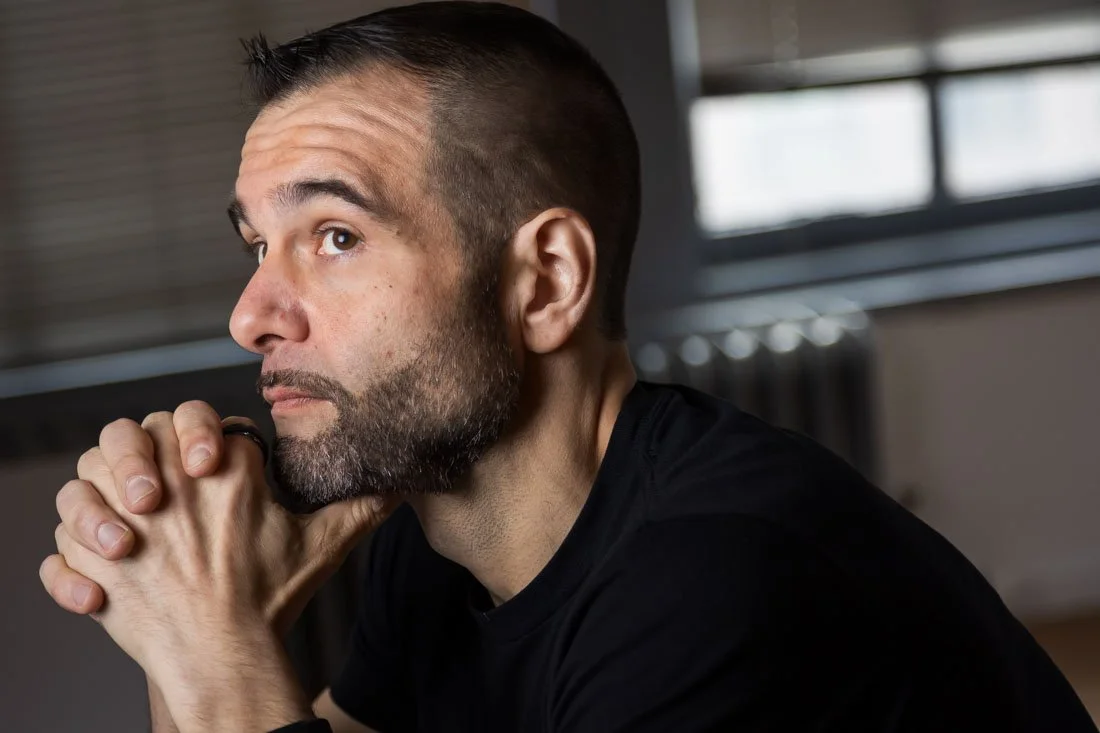Why Hunting for Clients Is a Losing Game
I hate cold outreach.
It, at certain slow times in my business, has become a necessary evil.
The endless LinkedIn searches for people with the “right” job titles. The impersonal messages that scream “I’m copying and pasting this to 500 people.” The follow-up sequences that make you feel like a digital door-to-door salesperson. The waiting. The silence. The generic “not interested” responses when you do hear back.
It’s a numbers game built on hope, not strategy. And yes, while it ultimately leads to some traction, especially done with a genuine, personal touch, at the end of the day, you’re throwing darts blindfolded, hoping one sticks to someone who might possibly need what you offer and has the budget to pay for it.
Regardless, even when cold outreach lands you an opportunity, you’re starting every conversation from a position of weakness. You’re the one who interrupted their day. You’re the one who has to prove your worth. You’re the one justifying why they should give you their time and money.
What if there was a completely different approach? What if instead of chasing prospects, the right prospects found you? What if they arrived already convinced of your value, expecting to pay premium rates, and eager to start working with you because they get the sense that you’re the type of person they’ll actually LIKE to work with?
That’s the power of strategic visual storytelling.
And it’s the difference between hunting for clients and attracting the ones who are ideal for your business.
The Cold Outreach Trap
Most experts and Founders are stuck in what I call the “convincing cycle.”
They spend their days trying to convince decision makers they’re worth hiring or buying from, convince them their services and product price points are justified, convince them to move forward.
This happens because cold outreach puts you in a fundamentally weak position. When you reach out to someone who doesn’t know you, hasn’t asked to hear from you, and has no context for your value, you’re immediately fighting an uphill battle.
Consider what actually happens with most cold outreach:
You find someone with a promising LinkedIn profile. Maybe they’re a VP of Sales at a growing company, or a successful consultant who seems like they’d value your services. You craft what you think is a personalized message, hit send, and wait.
If they respond at all, the conversation starts with skepticism. Who are you? Why should I care? What makes you different from the 35 other people who messaged me this week?
Even if you manage to get a meeting, you’re spending the entire conversation trying to establish credibility, justify your approach, and overcome their natural resistance to being sold to. You’re not having a strategic business conversation – you’re having a “convince me you’re worth my time” conversation.
And here’s the worst part: you have no idea if they’re actually a good fit for your business. You targeted them based on their job title and company size, but you know nothing about their actual challenges, their decision-making process, their budget, or their timeline.
You’re flying blind, and heading straight to the side of the mountain.
The Attraction Alternative
Strategic visual storytelling flips this entire dynamic on its head.
Instead of interrupting random folks with your pitch, you create a consistent visual presence that attracts the right people to you. Instead of starting conversations by proving your worth, decision makers approach you already convinced of your value.
Think about the last time you discovered an expert or business leader whose work resonated with you. Maybe you saw them speak at a conference, watched their content on LinkedIn, or found their website through a Google search. By the time you reached out to them, you weren’t skeptical – you were interested, leaning in and even excited to connect.
That’s what happens when strategic visual storytelling is rocking and rolling at full speed.
Your ideal clients discover you through your consistent, professional visual presence. They see how you show up online, how you present your expertise, how you document your work and the results it creates for your audience.
They get a sense of who you are, what you stand for, and what it might be like to work with you.
By the time they contact you, they’re not questioning your credibility – they’re wondering if you have availability and are a financial fit for them.
What Strategic Visual Storytelling Actually Does
Most people think professional photography is about “looking good” in pictures. That’s like saying architecture is about “making buildings pretty.” That’s missing the forest for the trees.
Strategic visual storytelling serves three critical business functions:
First, it pre-qualifies your audience. When someone sees consistent, professional visual content that reflects expertise and premium positioning, it immediately signals that you’re not competing on price. People bargain shopping naturally filter themselves out, while those prepared to invest in quality are naturally drawn in.
Second, it builds authority before you ever open your mouth. When prospects see you consistently sharing insights, documenting your work, and presenting yourself professionally, they develop trust in your expertise. You’re not an unknown quantity they need to evaluate – you’re a credible authority they want to engage.
Third, it creates emotional connection at scale. While cold outreach feels impersonal and transactional, strategic visual content lets people get to know you as a human being. They see your personality, your approach to work, your values in action. They don’t just think you can solve their problem – they feel like they WANT to work with you specifically.
This is why strategic visual storytelling is a better bet than cold outreach. You’re not INTERRUPTING people with your message – you’re INVITING them into your world, letting them decide if it’s where they want to be.
The Premium Pricing Psychology
Here’s something most people miss about visual storytelling: it doesn’t just attract better clients, it trains them to expect premium pricing.
When someone discovers you through high-quality, strategic visual content, they immediately place you in a different mental category than someone with amateur photos or generic stock images. Your visual presentation becomes proof of the quality they can expect from your work.
This is basic psychology. People make judgments about competence and value within milliseconds of seeing visual content.
If your LinkedIn profile shows a professional headshot that conveys confidence and expertise, if your website features thoughtful photography that showcases your work environment and process, if your social content consistently reflects sophistication and intentionality, prospects automatically categorize you as “premium” rather than “commodity.”
This means when they finally reach out, they’re not shopping for the cheapest option – they’re looking for a top-flight solution and expecting to pay accordingly. You skip the entire “justify your rates” conversation because your visual positioning has already established that you operate at a different level.
Compare this to cold outreach, where you’re often competing against whoever else happens to be pitching them that week. When someone finds you through strategic visual positioning, there’s no competition – you’re the expert they discovered and decided they want to work with.
Your Attraction System
This is where most professionals get stuck. They understand the concept of visual storytelling, in theory, but don't know how to systematically create and maintain it. They post randomly, use outdated photos, or rely on generic stock images that do nothing to differentiate their brand.
A comprehensive visual storytelling library solves this by creating a systematic approach to building your visual presence across three strategic categories:
Core Assets are your versatile business infrastructure – headshots, wider portraits, and vertical portraits with direct eye contact and genuine expressions. These foundational assets refresh as you evolve your appearance and business, powering your website, speaker kits, media interviews, social profiles, and bureau pages for speakers. They establish your professional credibility and create consistency across all touchpoints while signaling you're in demand, relevant, and premium.
Visual Evidence shows how the sausage is made – capturing moments of solo work like researching, brainstorming, and reflecting, plus client-facing work during the before, during, and after phases of the experience. These images, acquired during real moments and events or recreated in branding sessions, power your website, speaker materials, thumbnails, slides, online content, and handouts. You can also capture these micro-moments with your smartphone to fill gaps in your story while reinforcing credibility and making you more relatable for direct social media sharing.
Missing Details document the professional signals and personal touches – books, awards, achievements, intellectual property, and behind-the-scenes moments with your team, podcast, or masterminds. This includes hobbies, daily routines, community work, family moments, and meaningful objects captured during actual events and branding sessions with professional photography, or chronicled with smartphone photos to "yes and" the details that add quirks and aspects of your day-to-day life. These become launch marketing materials, online content for stories and carousels, and promotional assets. These help paint the full picture of who you are and how you help others.
When all three categories work together systematically, they create a comprehensive visual narrative that attracts ideal clients while repelling poor fits.
Prospects don't just see what you do – they see who you are as a human being, how you approach your work, and what makes you a market of one.
Moving from Hunter to Magnet
Strategic visual storytelling represents a fundamental shift in how you approach business development. Instead of hunting for prospects, you become a magnet for the right opportunities.
This doesn’t happen overnight, but it happens consistently.
When you commit to strategic visual storytelling, you notice qualified prospects discovering you through your content. You start receiving inbound inquiries from people who’ve been following your work. Sales cycles start to get shorter. You find yourself in conversations where prospects are asking about your availability rather than questioning your value. And those people you meet in real life find themselves on your call calendar more often.
Most importantly, you stop dreading business development.
Instead of forcing conversations with reluctant prospects, you’re engaging with interested clients who already understand and appreciate what you offer.
Your visual presence becomes your most powerful business development tool – working while you sleep, attracting the right people, and positioning you as the unmistakable choice for those ready to invest in quality solutions.
Ready to Stop Chasing and Start Attracting?
If you’re tired of cold outreach and ready to build a visual presence that attracts qualified prospects at premium rates, it’s time to develop your strategic visual strategic library.
The shift from hunting to attracting doesn’t require luck or perfect timing – it requires intention and systematic execution. When you invest in strategic visual storytelling that showcases your expertise, demonstrates your process, and reflects your premium positioning, you create a business development engine that works continuously.


